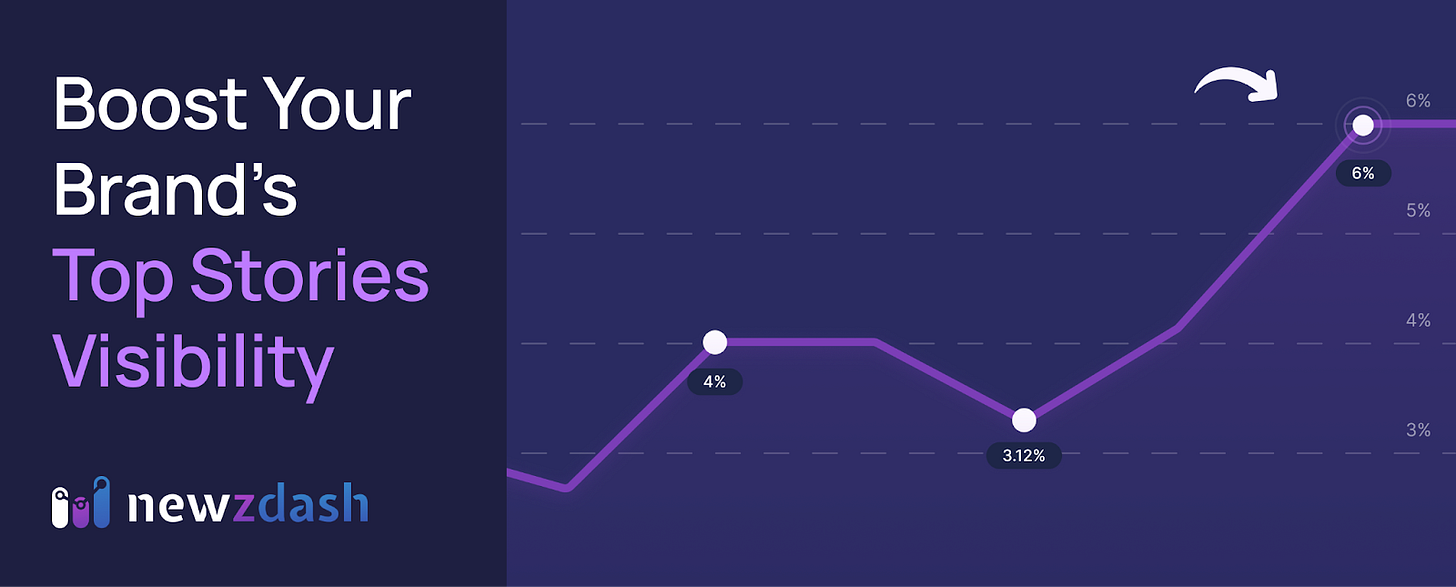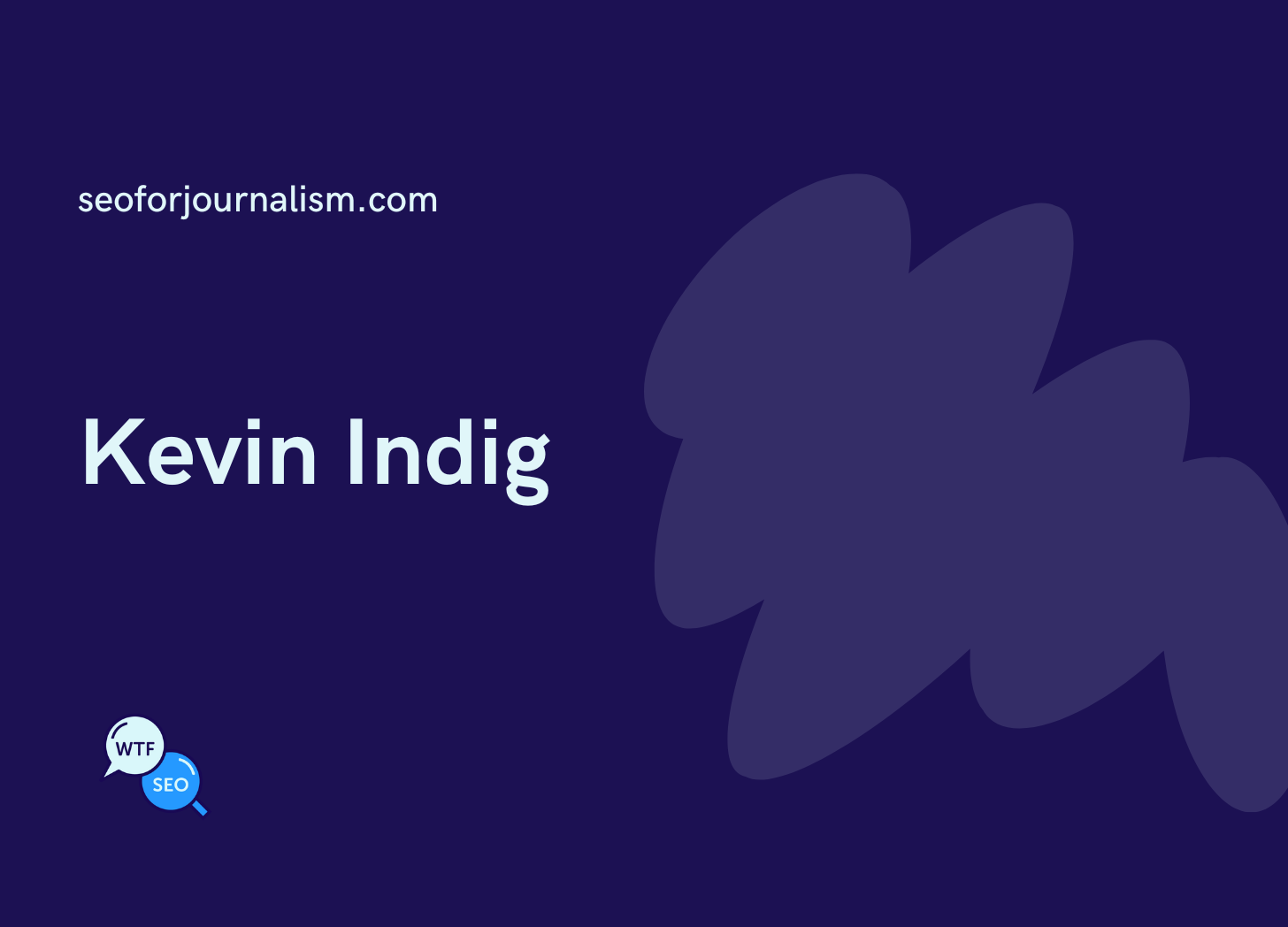Ask a News SEO: Kevin Indig
We talked about the query fan-out technique, Kevin's AI Overviews UX study and what publishers need to know about our AI future.
#SPONSORED
🏆 NewzDash Tracks AI Overviews for all Trending News Queries
The ONLY SEO platform built for real-time Google Search, News & Discover.
✅ AI Overview Tracking
✅ Real-Time Search Volume
✅ Unlimited Trends Rankings
✅ Historic Performance & KPIs
✅ Global Competitive Analysis
✅ Publish-to-Indexing Tracking
✅ Instant SEO Recommendations
and much more!
Hello, and welcome back. Jessie and Shelby here, back from lovely summer weekends. Jessie spent a morning exploring the history of the city’s waterfront and seeing hometown heroes PUP live (twice. So worth it.). Shelby spent the weekend in the suburbs pretending (or not?) to be a mermaid and making questionable bush fires. You can take the girl out of the country, but…
This week: Ask a News SEO with Kevin Indig! We were so excited to have Kevin, an industry-leading growth advisor, join us for a chat about the future of AI and search. We talked about the query fan-out technique, his AIO UX study and what publishers need to know.
Let’s get it.
THE INTERVIEW
WTF is SEO?: Is AI Mode the future of search? If yes, why?
Kevin Indig: That is an easy one — just kidding. To answer the question directly, I would say yes — it is the future of search.
There are a couple of things that lead me to believe that. One is the way that Google leadership talks about AI Mode. [Google CEO] Sundar Pichai went on the Lex Fridman podcast to say they're going to embed AI Mode in the regular search experience. Then, you have Elizabeth Reid, the head of Search at Google, say the search results page is a construct.
They're very bullish about AI Mode. They have a high interest in bringing this to the search results. There is a transition period obviously, which we're in right now. They're slowly going to bring AI Mode more and more in front of their user base.
The reason that's important is because not all users are ready for AI.
We [people working in SEO] are deep into tech, deep into SEO. We know how search works from a very different perspective than, say, my mother who's in her 60s. If you put AI Mode in front of her, she'd probably be very confused at first.
There is a generational gap that Google needs to fix to get this transition right.
The second reason why I believe that AI Mode is the future is how much they have already changed Search to look more like ChatGPT in the last three years.
WTF is SEO?: Interesting. Is Google changing because it’s a better experience or they don't want to look like they're getting left behind?
Kevin Indig: They're catching up. I personally think text is not the end interface. It's probably audio or video.
But Google is catching up — it’s the typical incumbent playbook. Look at Facebook, for example. When they were threatened by Snapchat, they put Stories into Instagram and fenced in the growth of Snapchat. Or with TikTok. YouTube followed the exact same playbook. TikTok was super popular for short-form videos. Boom. All of a sudden, YouTube has Shorts. TikTok is growing, but YouTube is exploding.
It's a typical playbook: Copy the most successful features of the challenger to slow down their growth. The beauty of being the incumbent is you know you can let the challenger run all the experiments, then emulate them. I don't want to say “copy,” because it's not a perfect copy, but you can play it safe. It can also backfire if you're too lenient.
It does seem that Google is emulating and weighing their options. They're very careful.
They're obviously under a lot of pressure from a monetization perspective and from a shareholder perspective. You can see in how Sundar Pichai talks on earnings calls and in interviews, that he's very, very shareholder-focused.
WTF is SEO?: How would you talk to people in publishing about handling Google volatility and AI Mode broadly?
Kevin Indig: Publishers are by far the biggest victim of the rise of AI.
Google’s AI Overviews and AI Mode are going to be devastating in terms of traffic. One of my predictions is that Google will add Top Stories carousels to AI Mode — it’s a hope, and it's a prediction. Otherwise, it's going to be really, really tough for publishers to survive.
I don't have the data for this yet, but in my experience, ChatGPT is showing a lot more Top News carousels. There’s some data showing traffic from ChatGPT to publishers has exploded over the last 12 months, but it's not enough to compensate for the traffic drop [from Google Search]. Long story short, I think publishers are in a real crunch.
WTF is SEO?: How significant of a change is query fan-out for how Google search works?
Kevin Indig: I think it's very overhyped. Overhyped as in, the response to query fan-out has been to target all the related user intents — but that’s something SEOs should have done many moons ago.
The basic action to optimize for query fan-out is nothing groundbreaking. We have ingrained workflows to start with keywords and maps to topics, but the process of creating and prioritizing content is still very outdated. It’s becoming even more painful with query fan-out.
WTF is SEO?: Could you explain how the query fan-out works?
Kevin Indig: What happens behind the scenes is that when you prompt Gemini — say through AI Mode, but also on other surfaces — Gemini takes that prompt and turns it into synthetic queries.
That basically just means it tries to guess which queries or keywords are most relevant to answer your prompt. Then, it will fan out into different user intents.
Say you’re looking for a restaurant within the next five kilometers of where you are that has good Wi-Fi, vegan options and is dog-friendly. From a pure classical keyword entity perspective, that is very hard to make sense of. How do all these things fit together? What's the relationship between Wi-Fi, dog and vegan? That is too hard to parse — at least in single vector models.
What Gemini tries to do is take the intents underlying the query and search the web, its Knowledge Graph and all the data that Google has access to — including the shopping graph and topic layer — and then brings back the results from all of these queries and stitches all these answers together to the final response that you get from Gemini in AI Mode.
It turns your prompt into queries, then gets results and stitches that back together.
Covering all the related user intents is very similar to the idea that a single page can rank for thousands of keywords. The reason is that all these keywords express the same intent or a related intent.
The way to respond would be to start with topic maps — which are distinctly different from keywords, even though keywords still appear within topic maps. Start with an overview of the core topics and identify all the important user intents within those topics. Then, translate those into keywords to measure how they perform. Then, create content for all these intents. It’s the same approach that you want to take for “modern SEO” as for this query fan-out technique.
WTF is SEO?: Let’s talk about your UX study for Google's AI Overviews. What are your biggest takeaways?
Kevin Indig: Most of my viewpoints are informed to some degree by that study. I teamed up with a research partner and conducted a usability study of 70 participants in the U.S. across different age ranges and devices. We gave them eight tasks to solve on Google — find a tax account near or find out this medical information, etc.
We recorded their actions and comments. We recorded everything from scrolls to hovers, to where they clicked. Combined with their annotations and comments, we were able to create this huge body of content.
We analyzed all of that data. Out of it came a body of research that changed fundamentally how I approach SEO.
To highlight the three biggest takeaways: One, we found that clicks are dropping significantly.
We did not look at clicks before and after AIO. We were able to compare search results without AI Overviews and search results with AI Overviews. It's not an apples to apples comparison — it’s an apples to oranges comparison. But, it's interesting because of course you see clicks drop by half and more.
What's even more interesting is that clicks are actually not that important unless you're a publisher. What we found is that there is this big difference between where people click and where they complete their search journey. We call this the final answer: the place where you get the information that you're looking for, and then you stop searching.
We found that in 80 per cent of cases, organic results — not the AI Overview — gives the final answer.
So, even though clicks are melting, organic search results still provide the final answer. There's still a ton of value. It's just that all the formational steps beforehand, they're basically being covered by an AI Overview. Again, if you're a publisher, that hurts.
The second interesting finding is the role of trust. The old way people look at search results is by relevance: “Does this answer my question? Does it have the information I want?”
The new way is a two-step filter. First, people evaluate the search results by whether they trust the source or domain. Then, they assess relevance. If the searcher doesn't already have a preconceived notion about your brand or who you are, you’re almost invisible. People gravitate toward familiar brands first, and then scan for relevance. That shift has all sorts of implications.
I’ll highlight one more interesting point: the importance of demographics. Younger users — very broadly, those under 35 — tend to be much more receptive to AI-generated answers.
They believe it faster. They accept it faster. They’re also more likely to double-check information on Reddit than on YouTube.
Older people tend to skip AI search results altogether. They go straight to the classic search. They don't trust AI. It’s critical to understand the age bands that they're targeting.
Something to highlight for publishers is the importance of how easy it is for people to find information.
One vivid example [from the study] is where a person was looking for a piece of information and they clicked on U.S. News & World Report and skimmed the article, and they stopped at a box with key takeaways — three bullets with the key information they were looking for.
These little quality-of-life helpers — navigation and orientation features — are so important for people to find the right answer. They're much more likely to bounce if they have to search for too long.
WTF is SEO?: Does that mean publishers need brand visibility across the entire internet?
Kevin Indig: It's such an interesting question. SEOs used to be very focused on our own sites — unless it came to off-site work like link building. That was the typical approach. But now, focusing on your own site is just the first step. You also have to think about all the different ways people double-check and verify information. If you’re present where people check information — places like Reddit, YouTube or third-party review platforms or niche forums — it can be incredibly powerful.
I’m seeing more clients and companies hiring full-time Redditors to engage on that platform, and I think it makes a lot of sense because you have to take a swing to invest in it. That said, it’s also really hard to measure the impact of that kind of off-site trust-building.
SEO is fundamentally changing because of how people are building trust.
And interestingly, the Quality Rater Guidelines also list trust as the most important E.E.A.T factor. That really clicked for me when I saw the usability research. I thought, “Now I finally know what they want.”
#SPONSORED - The Classifieds
Get your company in front of more than 13,000 writers, editors and digital marketers working in news and publishing. Sponsor the WTF is SEO? newsletter!
THE JOBS LIST
These are audience jobs in journalism. Want to include a position for promotion? Email us.
The New York Times is hiring a Technical SEO Manager (Core News) and Technical SEO Manager (Cooking). (Both jobs located in N.Y.)
The Times and The Sunday Times is hiring a Head of Newsletters (London, U.K.).
RECOMMENDED READING
Google news and update
🤖 Google: The June core update has finished rolling out.
🤖 Roger Montti: Google's June 2025 update analysis: What just happened?
🤖 Google Search Central Blog: An improved way to view your recent performance data in Search Console.
🆚 Matt Southern: Google added a comparison mode to Search Console's 24-hour view.
Even more recommendation reading
🏡 Barry Schwartz: Google’s homepage search box is rolling out a button for AI Mode.
⬆️ Lily Ray: AI search is booming, but SEO is still not dead.
💪 Kevin Indig: Topic-first SEO: The smarter way to scale authority.
🔗 Tom Capper: The great decoupling of clicks and impressions [Whiteboard Friday].
💥 Melissa Popp: Why publishing more content may be hurting your SEO (and what to do instead).
🚨 Emma Roth: News publishers take paywall-blocker 12ft.io offline.
What did you think of this week's newsletter?
(Click to leave feedback.)
Catch up: Last week’s newsletter
Have something you’d like us to discuss? Send us a note on Twitter (Jessie or Shelby) or to our email: seoforjournalism@gmail.com.
Written by Jessie Willms and Shelby Blackley








